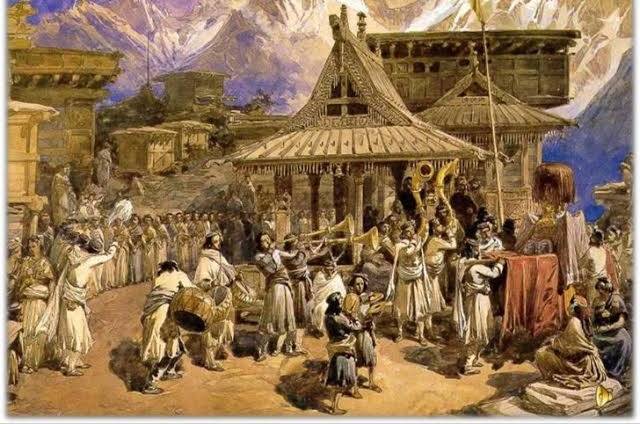SWANGLA
LOCATION-
–Swangla lives in the Pattan valley tract along the Chandra-bhaga in Lahaul Spiti district.
-It includes both Brahmin and Rajput.
–Swangla resembles the munda speaking tribe of Bengal, Bihar and central India. Chhang is their local drink
LANGUAGE-
Two types of language are spoken by Swanglas.
Manchhad-
This is the first language and it is a mixture of Tibetan and Hindi and is spoken by Brahmins Rajput and swanglas
Chinal and Bhoti
– chinal and Bhoti are also prevalent, but is only spoken by the Bodhs inhabitants of the valley Tinen or Tinent is spoken in Sissu area.
RELIGION AND CULTURE
-Two famous temples of the swanglas are Trilokinath and Markula at Udaipur
-The Brahmin swanglas also believe in ghosts and evil spirits. Their main sacred centre is Manimahesh in Bharmaur.
-Trilokinath fair is celebrated by them in month of August-September.
MARRIAGE SYSTEM-
–RUSTA-TE-BYAH -Marriage through elopement- in this case girl and boy fall in love and marry.
–KUA-BYAH -marriage through capture -boy picks up the girl forcibly with the help of his friends and marry her
MAZMI BYAH– if boy is unable to bear marriage expenses, he sends his sister to
bring the girl, and start living with the girl.
DIVORCE SYSTEM-
Tsud-thvagchi -in this system couple holds the thread and break it that symbolise breaking for matrimonial bond
-“Garu “and “Munda” groups are believed to have come up as result of Rajput marrying a Bodh girl socially belonging to the lower strata
ANNAPRASHANA– ceremony where child is fed with cereal food for the first time
PAGWAND
The property is inherited in the male line with all sons equally, this is known as the law Pagwand .
COMMUNITY COUNCIL
Community council is headed by a “Sehna” which means chief
GADDIS
-Gaddis are semi nomadiç, semi pastoral, and semi agricultural tribes.
-Word Gaddi had been derived from “Gadar” a Sanskrit word for sheep. Bharmauris called abode of Gaddis and entire sub Tehsil is name as Gadhernier Gadiyar region
LOCATION– Gaddis inhabit in Bharmaur Tehsil of Chamba and parts of Kangra district
-Some Gaddis are also found in Nurpur tehsil They settled in Bharmaur which is described as kailash.
– Lord Shiva is principal god of Gaddis. They consider themselves the children of lord Shiva.
-Gaddis includes Brahmins, Rajput, Khatris, Thakuras and Rathis.
HISTORY–
-The gaddi Brahmins have a tradition that, their ancestors came from Delhi to Bharmaur the reign of Raja Ajia Varman (780-800 AD).
-While other section of Gaddi says that their ancestors fled from Lahore to escape persecution of early Mohammaden invasions. Their main reasons for coming to this area might have been the inaccessibility of the area. Where fear of invaders was much less.
– The couplet “Ujarya Lahore te vasya Bharmaur” indicates the place of migration.
RAJA SANSAR CHAND of Kangra fell in love with “Nokhu” a pretty Gaddi girl and made her his queen
-The local people call Gaddis as Mitra means friends.
LANGUAGE-
-The dialect used by Gaddis is western Pahari language of the Sanskrit Aryan families in northern group.
RELIGIOUS BELIEFS-
–They a believe in ‘Awtar’, ‘kelang’ and ‘Gugga’ Gods.
– Kelang who is king of all snakes is propitiated in the form of sickle called ‘Darat. It is kept by a Gaddi while shepherding, Gugga is considered the protector of cattle.
MARRIAGE SYSTEM-
Five types of marriage is prevalent in Gaddis
1.JHIND PHUNK OR BRAR PHUNK- if girl elopes with her lover without consent of
the parents.
2. JHANJRARA-
This marriage is by elopement consent, agreement and mutual
understanding among the relatives.
3.GHAR JAWANTRI-
In this marriage boy has to work as domestic servant in the house of would be father-in-law.
4.BATTA SATTA
The boy gets his partner in exchange of his real sister or a cousin.
5.DAN PUN
This is common type of marriage.
FAIR AND FESTIVALS
-Minjar in the month of July
– sair
-Patroru sagrand is celebrated on 1 of bhadon (aug-Sept),
-Manimahesh yatra etc.
DRESS
– CHOLA AND DORA -are traditional dresses. DORA is the most important dress of Gaddi men, women and children
-CHADRU is used by Gaddan to cover the head.
– Gaddis take their food four times. The breakfast called Nuhari or Duteloo, in the noon Kaller, the lunch and their dinner Balll Sur’ or Jhol is their local drink
